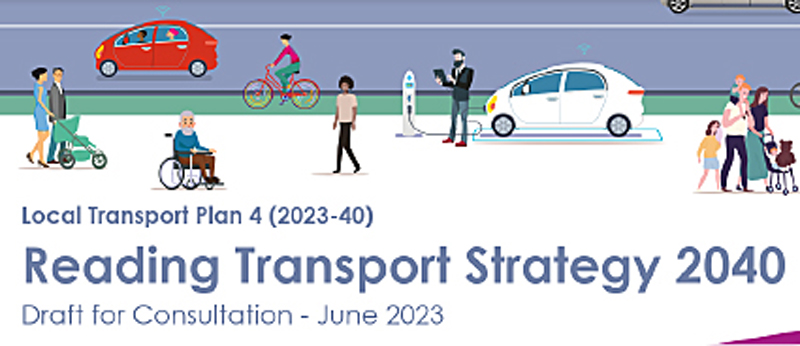We have recently spent a lot of time considering the Reading Transport Strategy. But given it’s a very long document (180 pages with around 10 appendices), it’s quite a daunting read for all but the most determined. So we’ve put together a brief summary of the document and the process, as well as the RCC response as part of the consultation on the Strategy.
First, the Transport Strategy, sometimes called a Local Transport Plan, is a high-level statutory transport planning document that is required by central government of all County Councils and Unitary Councils (such as Reading) across England.
There are very specific requirements of what goes into each Transport Plan. These plans have to be submitted to the Secretary of State for Transport and are key to successful bids for transport scheme funding to central government.
The Reading Transport Strategy sets out objectives for improving transport across the Borough to 2040 and how it is going to do this, backed up by a thorough review of existing transport, accessi-bility and pollution issues as well as anticipated future trends.
The Transport Strategy has identified seven key transport challenges:
- Adapting to the future – eg changing travel patterns due to working from home and increasing use of micro-mobility such as e-scooters.
- Improving air quality – this includes identifying those locations with specific air quality problems.
- Reducing congestion – in particular there is an issue with vehicles travelling through Reading town centre, especially between the M4 and South Oxfordshire.
- Affordable and accessible travel for all – ensuring travel in Reading is inclusive.
- Good accessibility to local facilities and employment – so that travel isn’t a barrier to opportunities for local residents.
- Healthier lifestyles – so that travel supports everyday health.
- Accommodating development – so that travel isn’t a barrier to new development.
Cycling plays a part in this Strategy, which identifies the objective of increasing cycling by 150% by 2040 – based on increasing the number of people cycling at least three times per week from 6% to 15%.
Development of the Transport Strategy is a long process that involves extensive data collection, consultation with adjoining Councils, local residents, businesses, transport providers and other stakeholders, including the hospital and university as well as representative groups such as ourselves. RBC have been working on this plan since 2019.
Ultimately, the Transport Strategy is more about wider outcomes, rather than identifying individual schemes, which is probably frustrating for a lot of people. But once agreed, it will filter down to other Council plans, such as the Local Walking and Cycling Infrastructure Plan (LCWIP), which does have details of specific schemes.
Generally, RCC would support the overall visions and objectives identified in the Transport Strategy, especially as an increase in cycling plays an important part in achieving these objectives. Also, an increase in cycling would contribute towards measures to address the seven key transport challenges identified.
However, there are issues that we remain concerned about.
A key issue is about future funding of schemes. It’s difficult to understand how the objectives of the strategy are going to be achieved if there is no funding to deliver local transport schemes and initiatives.
We have also raised the point that cyclists are a diverse group, ranging from novice cyclists, parents with children, school children, occasional cyclists, commuters, through to sports cyclists.
Whilst on-road cycle lanes are to be welcomed, these are more likely to appeal to existing cyclists who have the confidence and experience to ride in traffic. For most people who don’t presently cycle, road safety concerns mean that riding in traffic, even using on-road cycle facilities, is unlikely to be attractive.
If the objective of the Strategy to increase regular cycling by 150% is to be achieved, future cycle facilities need to be sufficiently attractive to encourage those that don’t presently cycle to take up cycling.
Therefore, the future cycle network needs to include a greater range of facilities – off-road cycle facilities, reduced traffic on residential streets, cycle and bus friendly traffic calming on local roads, more 20mph speed limits, routes through parks as well as school streets, not simply on-road cycle lanes.
Whilst much of the emphasis in the Transport Strategy has been about cycling for commuting or utility purposes, leisure and recreational cycling is important. Apart from the health benefits, leisure cycling is often a gateway to people taking up cycling on a regular basis.
Reading is a relatively compact urban area where cycling is a realistic option for many journeys. However, existing schemes need to be linked together to provide a coherent network and existing schemes need to be upgraded where problems have been identified.
Given the issues with funding, it is increasingly important that new development schemes make provision to encourage walking and cycling, not just for residents or users of a new facility, but for others walking or cycling through the area, thereby contributing towards the development of a coherent network.
A welcome ‘result’ is the inclusion of the RCC’s list of schemes and improvements as one of the Transport Strategy’s appendices. This provides a list of improvements identified by our members to improve their journeys.
We have suggested this list is updated and reviewed on a regular basis with the Council, as a way to add new schemes or opportunities for new routes which arise as a result of other transport schemes or development schemes. This would avoid problems such as the lack of cycle routes to Reading Green Park station.
Secure cycle parking at both ends of the journey is important to encourage cycling, as fear of having your bike stolen is a considerable disincentive to cycling for many people. Long-term parking should be secure and under cover, and should also accommodate bikes with child seats, electric bikes, cargo bikes etc.
We have also raised concerns about the quality of data used to monitor and assess schemes and progress towards objectives. Ideally, this needs to be from direct surveys rather than the less specific DfT traffic data.
Finally, we have suggested the need for a ‘cycle champion’ at RBC, to ensure proper focus on cycling issues in all policies and developments. This is especially important where implement-tation of schemes is undertaken by external consultancies, who don’t have necessary local knowledge.
RBC are presently reviewing the consultation responses and an updated document will be considered by Councillors later this year.
Tony Carr
RBC Campaigner for RCC


